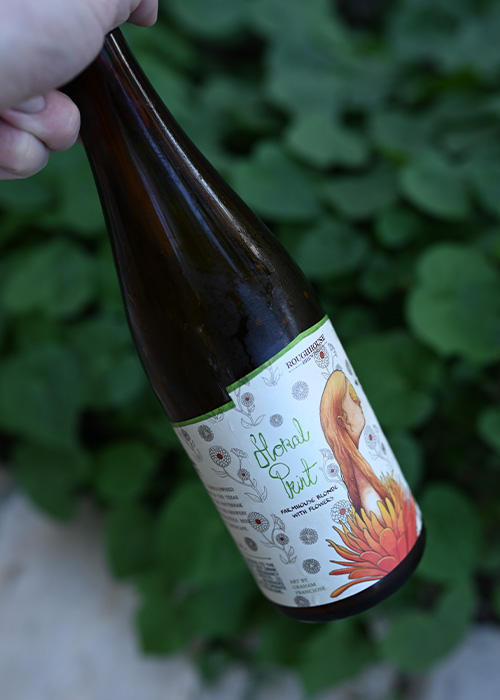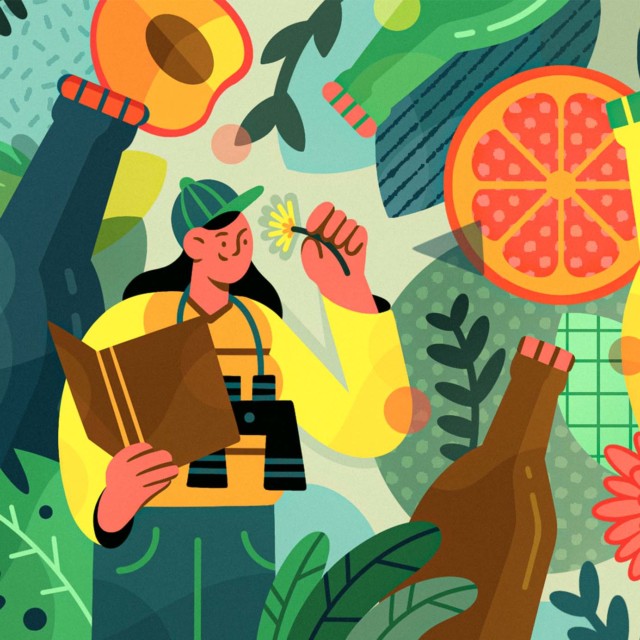This month, we’re heading outdoors with the best drinks for the backyard, beach, and beyond. In Take It Outside, we’re exploring our favorite local spots and far-flung destinations that make summer the ultimate season for elevated drinking.
One of the many reasons homebrewing is a hobby beloved by obsessives is that it lends itself to all kinds of geekery. There are the brewers who fixate on fabricating the perfect equipment; those who insist on growing each ingredient; and brewers who want to perfectly recreate their favorite beers from commercial breweries. Then, of course, there are those who make one-of-a-kind beers that could never sit on store shelves. In the last several years, the herbally curious, nature-loving brewing community has seen a rise in ultra-local homebrew recipes made with foraged ingredients, things gathered from nature (for free!) that are added to beer at any stage of the brewing process. These outdoorsy types are a new breed of homebrew geek, bringing together a passion for botany and a zeal for innovative brewing.
Enthusiastic foragers will tell you that there are quality ingredients ready for picking all year round, but many will agree that summer is the annual boom for foraging when flavorful berries, colorful flowers, and fragrant herbs are ripe for plucking from places as close as your backyard or local park.
Three brewers who have been tackling foraging since long before it became trendy are Scratch Brewing’s Marika Josephson, Roughhouse Brewing’s Davy Pasternak, and veteran homebrewer AJ Snapp. Their foraged beers feature forest-grown fungi, perennial herbs plucked from neighborhood lawns, and flowers from a farmhouse brewery’s own backyard.
So this summer get out there and gather for your next recipe with tips from the pros below.

Why Forage for Homebrewing Ingredients?
Beyond being an excuse to get out in nature, using foraged ingredients in homebrew brings an ephemeral quality to a batch of beer.
“A product using foraged or grown ingredients can’t be replicated,” says Davy Pasternak, co-founder and head brewer at Roughhouse Brewing. He adds that there is an “inherent complexity and uniqueness that can come from a whole host of things — tannin from seeds, herbaceous qualities from stems, wild yeast and bacteria.”
The Texas Hill Country brewer relies on this inherent complexity to make his signature farmhouse ales at the brewery located on the family ranch in San Marcos like “Friend and Berry,” a farmhouse ale made with agarita berries, or saison-style beers made with flowers that grow on the ranch.
In another part of the country, Marika Josephson, co-owner and brewer at Scratch Brewing, uses foraged ingredients to “capture the unique flavors and aromas of our part of the world,” which for Josephson is Ava, Ill. Sahti with juniper branches, Filé farmhouse ale with sassafras leaves, and wild cherry biere de garde with cherry bark are just a few of the Scratch Brewery creations using ingredients collected on the brewery property.
Meanwhile, veteran homebrewer AJ Snapp has almost 200 batches under his belt and has used a variety of foraged flowers, fruits, and herbs for his homebrew recipes at “Snapp House Brewery.” It’s the experience of discovery and experimentation that drives Snapp: “This is homebrewing. There are no rules.” He adds, “except ‘don’t poison yourself.’ So maybe there is one rule.”

How to Forage Safely
When foraging for a new ingredient for the first time, the possibility of brewing up a poison is very real, so it’s important to take steps to protect yourself.
“Start with plants you already know or that are easy to identify,” Josephson says. In order to avoid the threat of “look- alike plants”— for example, false hellebore is a highly poisonous plant that looks very similar to the ramp, prized by both chefs and home cooks — she suggests having a “good guide, whether it’s a person or a handful of books.”
Josephson’s own book, “The Homebrewer’s Almanac,” is a good place to start with information on the best seasonal plants, fruits, and vegetables for foraging safely — as well as how to best use them in homebrew.
Snapp, who is the acting beer expert at Pinocchio’s Beer Garden in Media, Pa., suggests “The Wildcrafting Brewer” by Pascal Baudar as another resource for reliably identifying safe beer ingredients.
Snapp says he feels safe in his foraging because he knows his neighborhood and that there isn’t a threat of unsafe chemical use on lawns in the area he forages in. It is best to stick to areas you are familiar with to avoid ingredients that may be contaminated with pesticides or other chemicals. Large fields and areas next to major highways are subject to being sprayed for pest control, as well as industrial waste water run off, so they should be avoided.
To find a personal foraging guide, Josephson suggests seeking a “plant society” in your local area, as these groups often organize guided nature walks. America’s State Parks is another resource for guide walks and assistance with plant identification.
Even if you do everything right as far as identifying and sourcing your plants, be mindful of anything that may look like mold, says Pasternak. Beer may naturally form a pellicle during fermentation: a thin layer on top of the beer that is usually white or creamy in appearance and typically stretches across the surface of the liquid. Mold tends to grow in isolated areas and will usually be fuzzy or hairy in appearance (unlike a pellicle). Especially if it is reddish, green, or black in color, you should dump the batch to keep everyone safe. (Here is a good resource for identifying mold from Milk the Funk.)
“It’s not pleasant, but no one wants to get sick,” Pasternak says.

How to Brew With Foraged Ingredients
With ingredients safely foraged it is time to add them to homebrew in a way that gets the most from their natural flavors, and avoids unpleasant off-flavors or infection.
Josephson says she tends to add foraged ingredients like the mushrooms in her Chanterelle Biere de Garde to the boil. This ensures the chanterelles are sanitized, leaving only the flavor (and none of the microbes) to make it through to the fermenter.
“The mushrooms are added throughout the boil with a big dose at the end,” Josephson says. The final beer “tastes like the woods smell when you go mushroom hunting in July and August here, a bouquet of apricot and earth.”
Pasternak takes almost the exact opposite approach at Roughhouse: “We will almost always add these ingredients to the cold side; either at fermentation temperature if sugar is present [like with fruit], or at 50 degrees Fahrenheit before crashing to package [the beer].”
He says that he is a proponent of pasteurization to neutralize any potential for infection coming from ingredients, as long as it doesn’t affect the quality of the final beer.
For Roughhouse’s new farmhouse ale Floral Print, calendula flowers from the brewery property are dehydrated and then added alongside Crystal and Strisselspalt hops as part of a dry-hopping addition. The flowers contribute a floral aroma, as well as an herbal quality that’s similar to green tea and chamomile.
Snapp says that foraged ingredients can be added successfully to almost any style. He suggests spruce tips in IPA, fruit purée in wheat beer, and dry hopping with flower petals. He sanitizes ingredients by “dunking them in StarSan” before adding them to the cold side of his brews.
As an easy way to get started, he says, “Figure out if that flower growing in your yard is edible, make a tea from it, and add it to whatever beer you just made.” It’s a similar method to how pro brewers add tea flavor to beer.

A Dandy First-Time Forage
Josephson suggests dandelions as the ideal ingredient for a first-time homebrew forager.
“Everyone knows what a dandelion looks like so there’s virtually no way to get it wrong!” she says.
Dandelions tend to be referred to as either a flower or a weed, but they are a perennial herb — meaning many parts of the plant can be used to lend a wild side to a batch of homebrew.
“The flowers can be used alone to add a bright floral quality,” Josephson says. “The whole plant can be used for a mild bittering addition. And the roots can be roasted and added to darker beers for a coffee-like aroma.”
Snapp agrees that dandelions are an excellent ingredient to forage for and brew with because they are so easy to identify, even a kid can do it — he enlists the help of his neighbors and their children to collect all the dandelion heads from their yards for his annual batch of dandelion wine. He says the resulting flavor is like an earthy red wine.
Go forth and forage!
Whether you get your whole neighborhood involved like Snapp, or find just enough ingredients at your closest state park to make a small batch, it is easy to get started with foraging.
According to Josephson, it only takes one dandelion batch and “I guarantee it will get you hooked on using wild ingredients in beer.”
